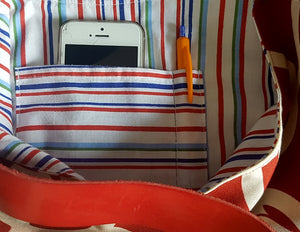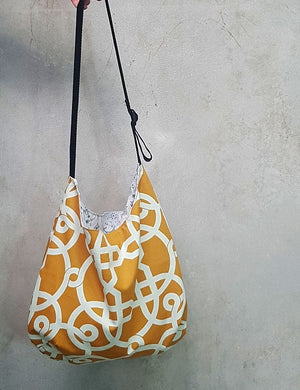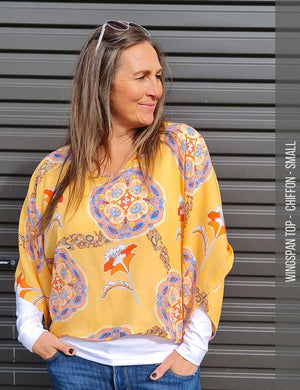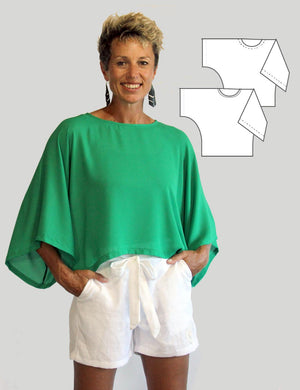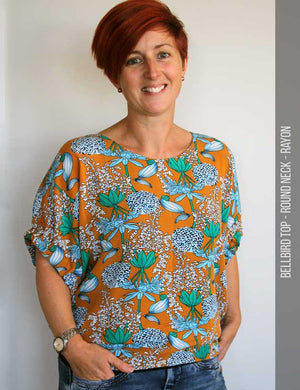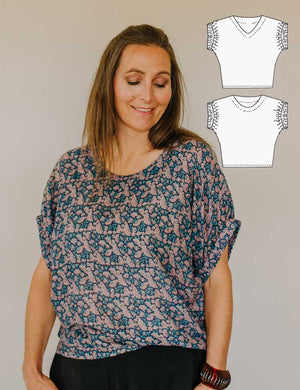Curves can be either concave or convex (either turning inwards or outwards). A convex curve turns outwards (like hemming the outside of a circle) and a concave turns inwards (hemming the sleeve edge of a sleeveless top).

A curved hem can be a little tricky if you want to prevent a puckered edge which looks messy and unprofessional.
There are several options to sewing a curved hem. The one you choose will depend on the finish you want, your skill level, or the type of curve you are sewing. This tutorial covers concave and convex hems with the following methods:
CONCAVE HEMS:
- Double turn under hem
- Single turn under hem (using an overlocker/serger or zig-zag stitch)
- Finishing with bias binding (tape)

The most professional finish is usually achieved with bias tape. You can buy bias tape or make your own (refer our tutorial). If you do not have bias tape, a double turn hem can be a little tricky, but if you take your time, can also achieve good results. The easiest method is a single turn hem with finished edge. A tidy finish (on the inside of the garment) is easy if you have access to an overlocker (serger), without which you will need to secure the raw edge with a zig-zag stitch.
When sewing any seam or hem you should use a coloured thread that matches your fabric. We have used a contrasting thread for illustration only.
1. DOUBLE TURN UNDER HEM

c) Turn under again 6mm (1/4") towards the wrong side and finger press.
d) Sew the hem in place massaging the fabric into the curve as you go. If your curve is particularly tight (like at the bottom of an arm hole), you may need to put a bit of tension on the fold, and it may pull in narrower than the 6mm (1/4") to enable the curve to be formed. This is OK.

e) Your completed double turn hem should be neat on both sides. 
2. SINGLE TURN UNDER HEM
Use an overlocker (serger) or in the absence of such, sew the raw edge of the fabric with a Zig-Zag stitch to stop the edge fraying. Turn under 1cm (3/8") once, press and top stitch in place.
You may have to narrow the hem where the curve gets steeper as it is harder for the fabric to bend the corner. The image below shows a completed single turnover hem with an overlocked edge.
To sew the same hem with a zig-zag raw edge finish, zig-zag the raw edge so that the furthest edge of the zig-zag stitch extends a tiny bit over the raw edge. This minimizes fraying. Turn under the edge 1cm (3/8") towards the wrong side of the fabric. Press and sew in place.

3. USING BIAS TAPE
There are two options with Bias tape:
- Turn the tape completely to the inside (so it doesn't show on the outside of the garment) - using single fold bias tape.
- Use double bias tape to enclose the hem edge to remain as a visible feature.

Bias tape usually comes folded in half with the raw edges tucked under towards the center. You can buy double or single folded bias tape;
i) Double fold bias tape, as pictured in orange & grey below, is wider with both the outside edges folded toward a center fold.This is used when you want the bias to totally enclose a raw edge of fabric on both sides (to fold it over the edge).
ii) Single fold bias tape, pictured in green below, does not have a fold in the centre. It's purpose is to sit flat when sewn. Single fold tape is ideal for hemming curves when you wish to turn the tape fullly to the inside. You can create single fold bias from double fold bias simply by cutting off one folded side edge.

For both methods:
a) Open out one side of the bias tape, and with right sides together, pin the right side of the bias to the right side of the garment along the first fold line, matching the raw edges.
b) Sew 'in the ditch" of the first fold line to attach the bias tape to the garment edge.
c) Press the garment towards the bias tape on the inside.
d) The next step depends on whether you intend to make the bias edge visible or to turn it all the way to the inside.
>To conceal the bias tape turn it all the way to the inside. Press, pin and stitch in place.

CONVEX HEM

a) Sew a baste stitch 5mm (1/8") in from the raw edge. A baste stitch is a longer stitch (than average) that will later be used to gather the outside edge.
b) Sew a second row 1cm (3/8") from the raw edge. This stitch line will act like a fold line in a piece of paper.
c) Pull the stitch closest to the raw edge (the baste stitch) to make a small gather, pulling the outside edge towards the wrong side of the fabric. Smooth the gathered edge to make sure the tension is even around the curve. Once the gather makes the outside folded edge pull in along the second stitch line, press in place.
d) Turn to the right side. Press again. Sew in from the edge to secure the hem in place.












